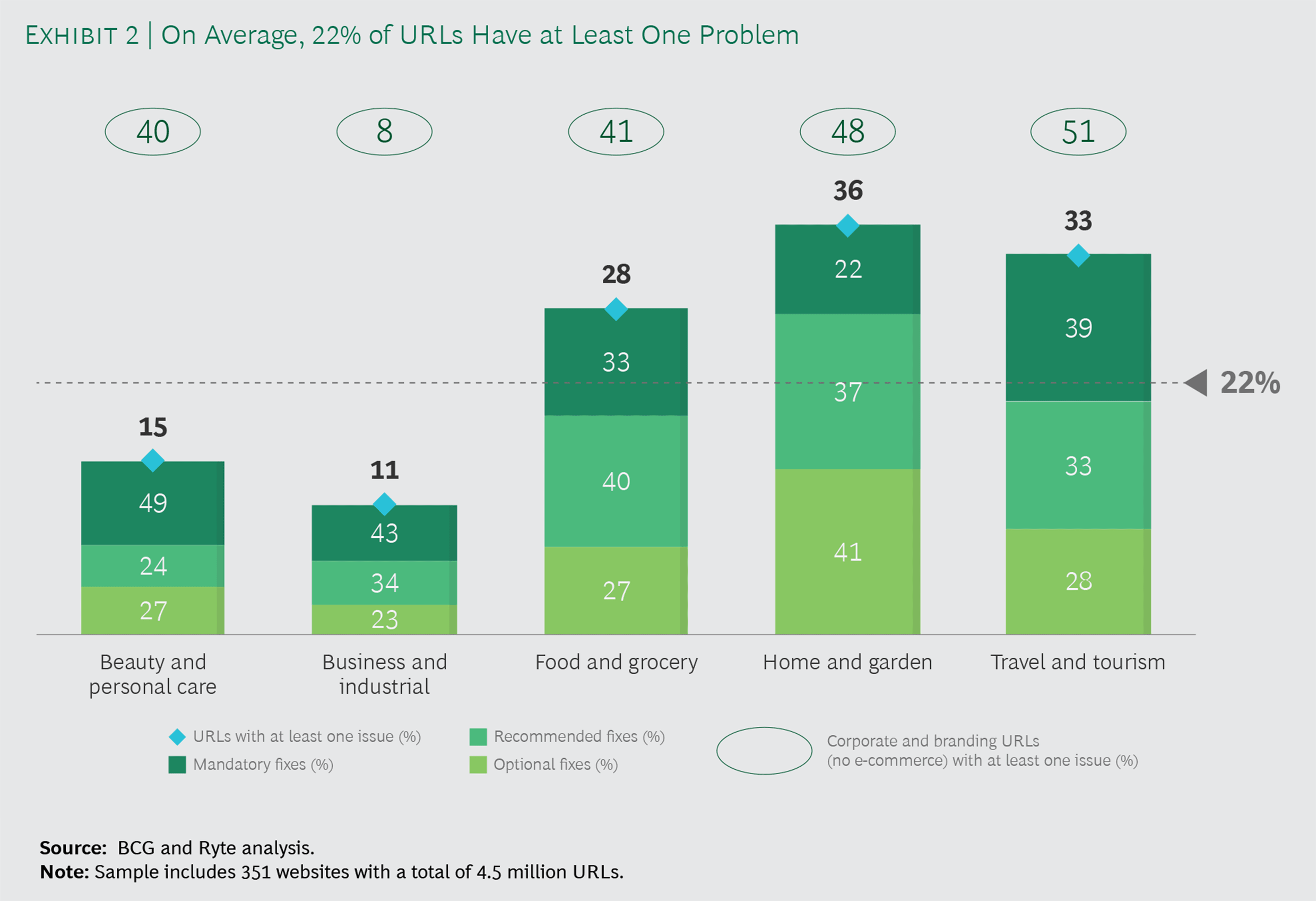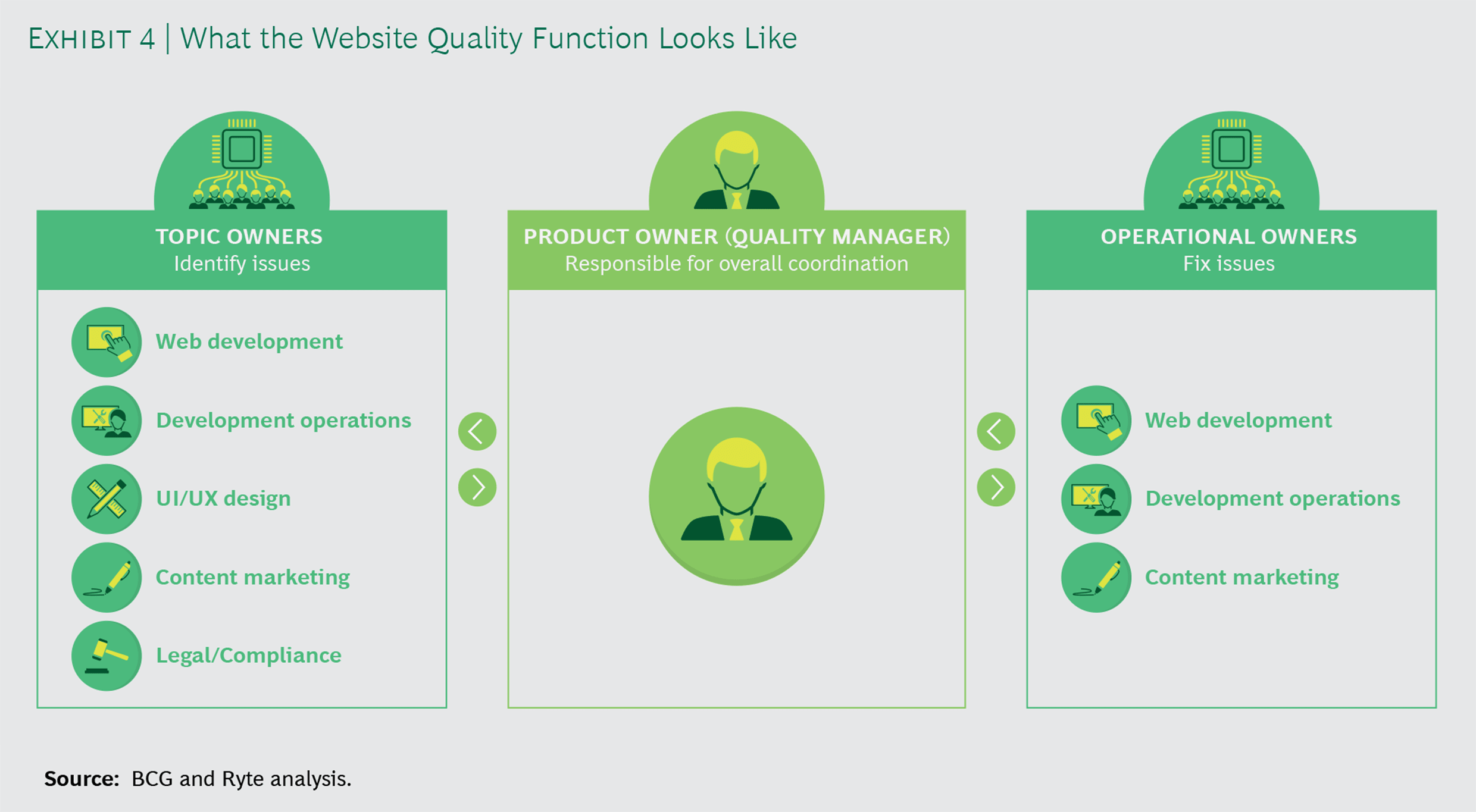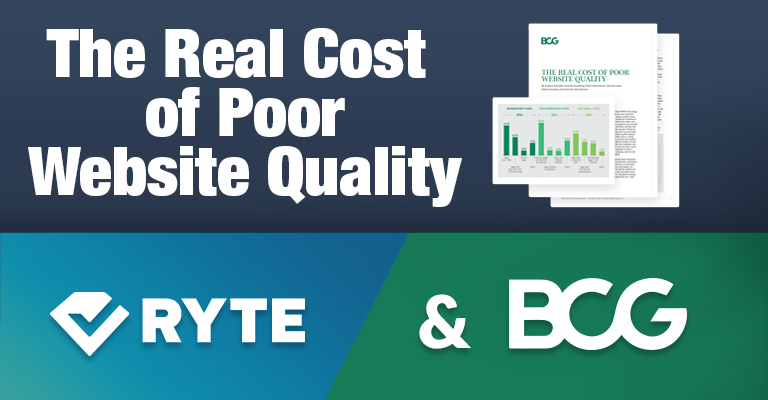By Andreas Schwabe, Andy Bruckschloegl, Frank Hohenleitner, Michael Kalus, Fabian Stueckle, and Korbinian Schmidhuber
This study was conducted by BCG in collaboration with Ryte, a leading provider of website quality management software. Original article published at https://www.bcg.com/publications/2020/real-cost-poor-website-quality.aspx
To grasp how vital digital marketing has become to business, look no further than the resources companies are dedicating to search engine optimization and the customer experience: global digital marketing spend in 2019 hit $304 billion, according to Magna Global USA. Yet while marketing leaders work tirelessly to ensure they’re on their target customers’ radar, they may well be neglecting the most insidious (and possibly the most serious) threat to that very effort: website quality issues.
The website is a business’s main point of entry for new and potential customers. But almost a quarter of all URLs have at least one website issue—bloated pages that load sluggishly, broken pages that don’t load at all, pages that are not linked internally—and on average, nearly 40% of these issues are critical in nature.
Lost visitors are eroding the effectiveness of marketing expenditure by as much as 20%, and companies are squandering thousands of dollars a month. That’s not counting the incalculable value of lost opportunity.
At the same time that COVID-19 has dampened website traffic for most industries (food and grocery being a notable exception), the massive worldwide shutdown of retail stores has pushed sales online. Considering how many companies not only fail to pay attention to the flaws on their websites but are actually unaware of their impact, that’s a problem. New research from BCG and Ryte, a website quality management software provider, shows a strong negative correlation between the number of website errors and the number of visits to a site. Dealing with such problems may seem like mundane work, but these issues are what prompt customers to abort a transaction, exit a webpage, and even defect to the competition.
Almost a quarter of all URLs have at least one website issue, nearly 40% of them critical.
Moreover, we found that most companies lack an established, systematic mechanism for dealing with errors in a coordinated, timely fashion. Errors will happen, but there’s no reason for website problems to persist. Marketing, tech, and legal teams, working together in a disciplined manner, can do much to monitor, fix, and—more important—prevent these problems and protect a company’s high-stakes digital marketing investment.
WHAT’S BROKEN?
BCG teamed up with Ryte’s website quality experts to analyze the most significant website problems and quantify their impact. We studied more than 350 websites of 20 major European companies and their 177 brands in a cross-section of industries. We gathered more than 300 data points for every URL and then selected the most significant 25 issues for our analysis. We grouped these issues into three categories: those for which fixes are mandatory, those that we strongly recommend fixing, and those for which fixes are optional.
- Mandatory Fixes. The most severe problems accounted for 37% of all the issues we identified—the biggest category. (See Exhibit 1.) Among the most common problems are oversized pages (those greater than 1 MB), slow-loading pages (those that take more than one second to load), and broken pages. These and other issues not only increase the visitor bounce rate but also directly affect a site’s Google ranking and, ultimately, its online sales.
- Recommended Fixes. These problems also need to be remedied, although not with the same level of urgency. They include indexable pages missing from the sitemap, pages lacking compression, and pages with so-called noindex/nofollow attributes (a lack of indexing, so that search engines can’t find them). All told, these issues accounted for almost one-third of the problems we identified.
- Optional Fixes. These problems (roughly 30% of the total) include, among other things, pages with a long click path, few internal incoming links, and nonindexable pages in the sitemap. Such problems do not necessarily (or directly) cause visitors to abandon a purchase or drop off a site, but they can annoy or inconvenience them enough to affect their experience, without the company even knowing it. They can also damage a site’s ranking by search engines.

We analyzed website issues by industry, looking at their distribution across five broad groups: beauty and personal care, business and industrial, food and grocery, home and garden, and travel and tourism. We also differentiated between e-commerce sites and corporate and branding sites.
Of all the URLs analyzed, 22% had at least one problem. (See Exhibit 2.) The largest number of issues turned up in the home and garden group (36% of URLs, on average, had at least one issue). But the highest proportion of the most severe problems turned up in beauty and personal care, with 49% of the total number. Sites in this industry group tend to be content-focused, with many embedded photos and videos; companies typically pay little attention to optimizing the size and delivery of these assets in order to improve load time. Oversized pages (those greater than 1 MB) accounted for 33% of issues in this category.

Corporate and branding sites had more problems overall than e-commerce sites. In four out of five of the industry categories, the average percentage of URLs with issues was higher for websites without an online shop (24%). Travel and tourism sites without an online shop had the highest percentage of errors (51% of URLs had at least one issue). These sites typically rely on legacy technology; slow server loading times, along with missing SSL encryption, represented 30% of all issues in this industry group. That’s compared to an average 7% among the other four industry groups. Home and garden was a close second, with 48% of all URLs having at least one issue. The distribution of critical issues was similar to the overall distribution. The business and industrial category had the fewest issues, as B2B sites in general have less functionality and are less complex.
QUANTIFYING THE COSTS, CALCULATING THE POTENTIAL VALUE
Most companies aren’t aware of the money that is falling through the cracks each month because of website quality issues. Recently, while examining ways to generate more website traffic for a large telecom client, we discovered that 8% of the company’s marketing landing pages had broken links. Without realizing it, the company had been losing 4% of its total traffic.
So what do website issues actually cost organizations? To get an idea, we analyzed two of the most critical issues: server loading time of more than one second, and pages larger than 1 MB. (See, “A Note About Our Methodology.”) Our team looked at how often these errors occurred for all 350-plus websites in our study pool by crawling the sites multiple times. We gathered visitor data over a period of 30 days and ran a regression analysis to examine the change in number of visits in relation to the severity of those two issues per URL, assuming a potential 1 million visitors per month. We also quantified the share of paid visits versus organic website visits, as well as the cost per click for the paid visits per industry and region. By combining both sets of results—change in number of visits per severity of issue and cost per click for paid visits—we were able to determine the monetary value of fixing technical web issues.
A NOTE ABOUT METHODOLOGY
What did we find? For one thing, server load time and the number of visits are closely correlated: the slower the load time, the fewer the subsequent visits to the site. Assuming 1 million potential visitors, the decline in future visits when load speed falls is precipitous; every additional second costs, on average, between $3,000 (for food and grocery sites) and $9,000 (for business and industrial). In terms of marketing spend, this translates into a 10% reduction in effectiveness. Every additional megabyte in page size amounts to average losses of between $4,000 (food and grocery) and $14,000 (business and industrial) per month, or the equivalent of a 7.5% reduction in digital marketing spend effectiveness.
The slower the load time, the fewer the subsequent visits.
Quality pays, but how much? What is the value of maintaining an error-free, fully functional site? In addition to analyzing the hidden costs of key website issues, we looked at the value of optimizing the effects of page size and server load times. Across all five industry groups, we found that companies can reap up to a 26% gain in the effectiveness of their marketing spend, with an average of 21%. (See Exhibit 3.) Food and groceries have the highest upside potential because of the significant deviations in both categories, while business and industrial has the lowest, largely because of the high proportion of sites that are brand-building only and receive no paid traffic.

INTRODUCING A QUALITY CONTROL MECHANISM
It’s a simple proposition: to prevent future losses, companies need to fix technical errors, starting with the most critical ones. Yet few companies have in place a structured process for proactively coordinating and overseeing quality. Once they’ve finished working together to launch new content or website elements, marketing and tech teams tend not to communicate much. But the problem runs deeper. At most organizations, no individual or department is responsible for website quality control. Quality improvement and user-experience projects are generally run from the marketing department, but marketing lacks the authority to prioritize the many tech projects underway at any given time in the enterprise. As a result, website quality projects do not get priority, which means they are often delayed, if not pushed back indefinitely. Meanwhile, errors get discovered after the fact, when the damage is already occurring.
Just as cross-functional teams work together to build digital assets (like the website), as well as other products and services, they can work together in agile ways to fix and maintain them. The first step in establishing a website quality function is to appoint a website quality manager (product owner). Two other key roles are topic owners and operational owners. (See Exhibit 4.)

Topic owners (whether departments or individuals) are responsible for monitoring and identifying problems, although not necessarily for fixing them. They are drawn from the technical teams that design and maintain the site itself: web developers (WebDev), development operations (DevOps), and user interface/user experience designers, along with content marketing and management teams and legal and compliance. WebDev is responsible for issue-free technical development and the operation of site elements, including technical SEO; DevOps is the team of development and operations engineers who work together through the service cycle. Operational owners are charged with fixing the problems; they’re in a position to know how feasible the fixes are and what level of effort and resources they will require. Operational owners come from many of the same technical teams (WebDev and DevOps) as topic owners, as well as from content marketing and management teams, when appropriate. Based on the information that the topic owners and operational owners provide, the quality manager coordinates the two groups, prioritizing and tracking issues and repair efforts.
Each department’s responsibilities should be clearly documented in detail and circulated to all team members. That measure alone goes a long way toward simplifying and accelerating remedial action. With dashboards and appropriate tools, members of the teams can carry out their work tracking, coordinating, fixing, and communicating. Using a management dashboard, the website quality manager continuously monitors company websites, mapping the various problems that arise by topic owner and level of criticality and determining which types of technical functionality belong to web developers and which belong to the DevOps teams. He or she assigns the appropriate operational owner to fix the issue, reporting progress back to the topic owner.
Few companies have in place a structured process for proactively coordinating and overseeing website quality.
Classifying the issues by urgency and severity helps companies prioritize and address them according to their monetary or legal impact. This approach is particularly helpful at a time when tech resources are demanding a growing proportion of marketing budgets. Our study revealed that 91% of all issues within DevOps’ purview are critical. As most issues fall within the scope of the web development team, closely followed by DevOps, these two teams deserve the appropriate resources—headcount, budget, expertise—to protect and preserve site quality.
RE-INJECTING VALUE BACK INTO THE MARKETING BUDGET
The internet is constantly and rapidly changing. Search engines are continuously enhancing their technologies and revising their methodologies and practices. Companies make frequent changes to their websites, such as adding new products and content or installing new data-gathering technologies. Errors, malfunctions, and performance issues can and do easily crop up. These become even more pressing with the growing dominance of mobile. Mobile users are less forgiving, and translating desktop sites into mobile versions is tricky, so errors can be even more punishing. And the impact of a host of other website issues may be at least as substantial as the issues analyzed here: broken pages, missing SSL encryption, duplicative content, overly long click paths. The price of ignoring these goes beyond wasted marketing money; companies pay the cost in a lost opportunity.
Quality control pays. Armed with an operating model and processes to oversee and ensure website quality control, companies can fix what’s broken, avoid future issues, and optimize their website continuously with the end customer in mind. In today’s new environment, e-commerce and online branding have become more important than ever, so ensuring website quality is among the most vital marketing investments. Without quality management, companies literally don’t know who—and what—they might be losing.

